Packed Full of Fantasy Goodness: The Deluxe Tunnels and Trolls RPG
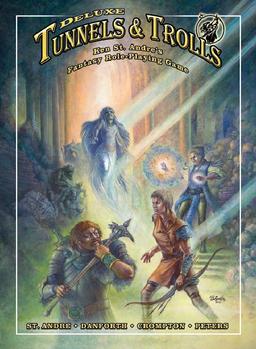 Back in 1980, on my last day of my first year at secondary school in the UK, an 11-year old me saw a kid with a copy of the paperback Advanced Dungeons & Dragons Players Handbook. I’d discovered Tolkien a year or two earlier, and, leafing through the book, the pictures of dragons and swords and — most particularly — the dungeon map and diagram of the Planes of Existence at the back both enchanted and fascinated me. But as an 11-year-old I hadn’t much pocket money, and on the first day of my summer holidays and clutching a single sheet pricelist catalog from Games of Liverpool, I spent £1.75 on the only thing I could afford which looked even remotely similar — a slim booklet called Buffalo Castle.
Back in 1980, on my last day of my first year at secondary school in the UK, an 11-year old me saw a kid with a copy of the paperback Advanced Dungeons & Dragons Players Handbook. I’d discovered Tolkien a year or two earlier, and, leafing through the book, the pictures of dragons and swords and — most particularly — the dungeon map and diagram of the Planes of Existence at the back both enchanted and fascinated me. But as an 11-year-old I hadn’t much pocket money, and on the first day of my summer holidays and clutching a single sheet pricelist catalog from Games of Liverpool, I spent £1.75 on the only thing I could afford which looked even remotely similar — a slim booklet called Buffalo Castle.
I had no idea what I was doing. When the booklet turned up at my house a few days later I realized it wasn’t even a complete game, but part of another game called Tunnels & Trolls — something called a “solo adventure.” Undaunted, I made up my own rules, played the hell out of Buffalo Castle, and made up several solo adventures of my own — and saved my pocket money for the rule book for Tunnels & Trolls.
Completely accidentally, I’d stumbled onto a path which would shape my whole life.
Fast forward 35 years (and try to say “35” quickly so you don’t feel it…). A couple of months ago I bought the newest and greatest ever edition of the Tunnels & Trolls roleplaying game, funded by Kickstarter over the past couple of years and only now hitting games stores and general release. Designed and written by Ken St. Andre, Liz Danforth, and James “Bear” Peters, and dubbed Deluxe Tunnels & Trolls, it’s effectively the 8th edition of the rules — but unlike many other RPGs, even this 8th edition isn’t too far removed from earlier editions, and if (like me) you grew up on the 5th edition rules, you won’t find yourself in too foreign territory. It’s very much the same game — just better.
Back in the day, T&T (as everyone called it) was great fun. But it always stood in the shadow of its Big Daddy, Dungeons & Dragons, which somehow laid claim to a more serious, bizarrely more legitimate form of fantasy roleplaying. But for a kid, the freewheeling nature of T&T was something as natural as breathing; when I switched over to D&D, with its more restrictive (and far more wordy) rules, we all assumed big solemn rule books like encyclopedias were somehow better, and after a couple of years of T&Ting, I moved onto more complex games.
Strange to say, then, that coming back to Tunnels & Trolls after all these years, I’m startled by how well the game has aged. It actually feels modern, in a way its contemporaries don’t. It even feels more modern than D&D…
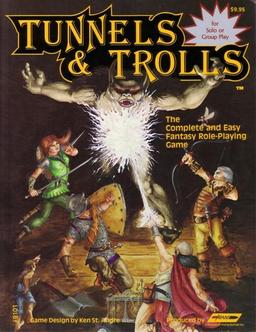
I should explain.
The past 15 years have seen a revolution in roleplaying game design. Rules systems have moved away from highly complex, monumental, and encyclopedic rules systems, to lighter games, with an emphasis on not having to look things up during play. Also, they’ve become somewhat less “concrete” and more “narrative,” by which I mean that the prevailing metaphor underlying the rules mechanics has become less of a one-to-one relationship between rolling the dice and completing a specific action, and more of a general rolling the dice to see whether you succeed at what you’re trying to do.
More “traditional” RPGs say: make a dice roll to see whether you hit with your sword / pick the lock / cast the spell. More “narrative” games say: make a dice roll to see whether you overcome your opponent / get past the door / use magic to solve your problem — and then describe to me how you do that. It’s a big philosophical difference, and one a lot of games have touted as their great innovation over the past decade and a half.
Except, of course, Tunnels & Trolls has been doing that from the very beginning. Its entire combat system, for example, revolves around rolling your weapon’s damage and comparing it to your opponent’s damage total, then declaring that the higher total wins and damages the loser — and then leaving it up to the players and game masters to describe precisely how that looks in the story. And, even more presciently, the way the players and GM have been describing the action before a roll is made is used as the basis for the limitations on how you can describe the results of your dice roll — whether that’s combat, trying to outwit a dragon, balance across a tightrope, open a locked door, work out a complex puzzle, or whatever.
Tunnels & Trolls has never specifically mentioned concepts like “narrativism,” “story telling,” or “game fiction,” but it’s been quietly putting those concepts into practice since the very beginning of roleplaying games, without fuss, and in a way that every player and GM can tailor just to his or her preferences. Reading it now in 2015 that comes as something of a surprise. And, of course, not only does it make T&T feel thoroughly modern, it also makes it possible to employ all the cool philosophical and technical revelations of the past 15 years or so directly with this new-yet-old game. There’s never been a better time to play or GM Tunnels & Trolls.
Hopefully that, at least, has caught your attention. No matter what kind of roleplaying gamer you are, the new Deluxe Tunnels & Trolls is worth a look.
The Physical Book
So let’s get to specifics. What do you get in the game?
Right. Well, first up, Deluxe Tunnels & Trolls is deluxe. It’s a chunky book; 368 pages, predominantly black-and-white but with multiple color plates, available in PDF and also in softback and hardback physical versions. It’s a nice-looking book; the cover art is by the iconic and inimitable Liz Danforth, whose artwork for me just is Tunnels & Trolls, and her illustrations ornament the whole book, with older classic pieces from previous T&T products rubbing shoulders with new or never-before-seen pieces, as well as artwork by Steve Crompton (including a beautiful map of the Trollworld setting) and classics by Rob Carver. The text is written and designed by the trio of T&T creator Ken St Andre, Liz Danforth (who also edited the whole game with the same beautiful clarity and precision of the 5th edition), and James “Bear” Peters (he of the legendary “Dungeon of the Bear”). The game is published by Rick Loomis of Flying Buffalo, who also ran the very successful Kickstarter which funded this new version.
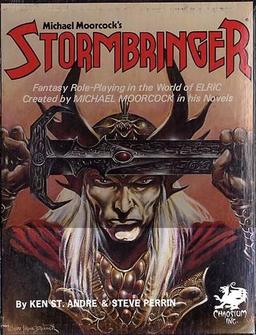 But although it’s a big book, the size of Deluxe Tunnels & Trolls is a little deceptive: the print is larger than many hardbacks, and the paper thicker, and more parsimonious producers could probably have squeezed the content into something about 2/3 the size. But T&T has always been big, cheery, and friendly, and the expansive feel of DT&T fits. But all the same bear this in mind: DT&T isn’t a wordy, over-written book. It’s a very complete game, but the rules are actually terse, non-complex, and easy to grok.
But although it’s a big book, the size of Deluxe Tunnels & Trolls is a little deceptive: the print is larger than many hardbacks, and the paper thicker, and more parsimonious producers could probably have squeezed the content into something about 2/3 the size. But T&T has always been big, cheery, and friendly, and the expansive feel of DT&T fits. But all the same bear this in mind: DT&T isn’t a wordy, over-written book. It’s a very complete game, but the rules are actually terse, non-complex, and easy to grok.
For one thing, over a third of the book is devoted to “Trollworld,” the DT&T setting, and sample adventures. Now, I should emphasize this: like D&D, T&T is an open FRPG which is modular and can be used for playing in any setting, including your own. Indeed, for most of its history there hasn’t really been a published official T&T setting. The august Ken St Andre, creator of Tunnels & Trolls (and many other games, including the awesome 1st edition of Chaosium’s Stormbringer), referred to an implied T&T setting in many of the solo adventures and GM adventures published over the years, but never provided enormous amounts of detail. We had tantalizing hints: names like Khazan, Knor, Khosht, the City of Terrors, the Dungeon of the Bear. But most of us who played T&T either ended up putting these places into our own campaigns, or just treating them as one offs without cartography or contextualization.
No longer! Deluxe Tunnels & Trolls, for really the first time in print, publishes lavish details of Trollworld: a gorgeous full-color map (by Steve Crompton), maps of the cities of Khazan, Knor, and Khosht, even featuring their underworlds, and fifty-five pages of gazetteers and descriptions of three of the world’s continents and countless islands and archipelagos. It’s a lovely thing to see, and very satisfying from a long-term player’s perspective.
There are a couple of things I’d do differently; I’d put clear and explicit scales on all the maps, for example, although maps without scales seem fairly common these days (me, I’m a mapper, so that kind of detail is important); plus I might have scattered some adventure hooks through the gazetteer material. But that’s gilding the lily; it’s awesome to see this stuff.
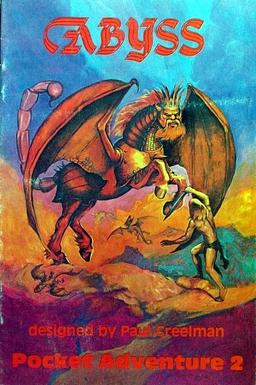 And then there’s the other two-thirds of the book, pages 1 through 226. If you know previous editions of T&T, you’ll be familiar with the structure: first comes “The Basic Game,” which is, basically, the whole T&T game — character creation, actions, combat, magic, monsters, GMing, etc. This is 155 pages long, plus 10 pages of spell list appendices. I’ll say that again: 155 pages for the whole game, in big friendly type. Other games would probably compress the text into 100 pages. And that includes 30-odd pages of spells.
And then there’s the other two-thirds of the book, pages 1 through 226. If you know previous editions of T&T, you’ll be familiar with the structure: first comes “The Basic Game,” which is, basically, the whole T&T game — character creation, actions, combat, magic, monsters, GMing, etc. This is 155 pages long, plus 10 pages of spell list appendices. I’ll say that again: 155 pages for the whole game, in big friendly type. Other games would probably compress the text into 100 pages. And that includes 30-odd pages of spells.
In other words, there aren’t mountains of rules in DT&T. At its heart it’s a simple game: but it’s flexible, intuitive, and lends itself towards on-the-fly adjudication and application to all manner of situations (it’s no mistake that there are also SF, modern espionage, and post-apocalyptic versions of the game out there). If you’re a fan of HeroQuest, or Fate, or Savage Worlds, or any of the “Old School Renaissance” games, you’ll find a lot to admire here. You can probably pick up the rules of T&T in an hour or two’s reading; everything else you’ll learn at the table during play.
The second third of the book, pages 166 through 226, is called “Elaborations,” and is similar to the section of the same name in T&T 5th edition: it’s essentially a container for house rules, variants, and modular additions to your game, including playing monstrous characters, languages, steeds, treasure charts, advanced rules for character “types” (a bit more archetypal than D&D character classes, but broadly similar), and so on. You don’t need any of this for play, but it’s there when you want it.
And, finally, the end of the book contains two adventures: one, a solo adventure called Abyss, which is basically for dead characters (you wanna get out of hell? Here’s how!), and the other a “GM adventure” called Into Zorr. Personally I wouldn’t have chosen Abyss as the featured solo adventure — it’s a bit niche, and doesn’t ooze with Trollworld flavor like other solos. I’d probably have chosen something like Goblin Lake, but either way it’s a good adventure.
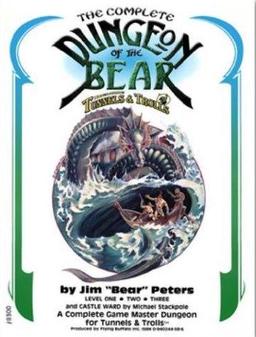 Into Zorr is an interesting adventure. My first gut feeling was that the Flying Buffalo guys should have chosen something like Dungeon of the Bear for their iconic GM adventure, but on mature reflection that would have been a bad idea: first, Dungeon of the Bear is probably too long for the core book and, second, it’s also probably a bit too old school — essentially a bare bones dungeon crawl. “Into Zorr” is a three-part adventure featuring social interaction in the city of Zkaria on the “Eagle Continent” of Zorr, an overland trek, and a final dungeon adventure — all of which together admirably showcase all the different things the DT&T rules can do. It’s a fine addition to the T&T oeuvre by the awesome Ken St Andre, and looks like it will play well.
Into Zorr is an interesting adventure. My first gut feeling was that the Flying Buffalo guys should have chosen something like Dungeon of the Bear for their iconic GM adventure, but on mature reflection that would have been a bad idea: first, Dungeon of the Bear is probably too long for the core book and, second, it’s also probably a bit too old school — essentially a bare bones dungeon crawl. “Into Zorr” is a three-part adventure featuring social interaction in the city of Zkaria on the “Eagle Continent” of Zorr, an overland trek, and a final dungeon adventure — all of which together admirably showcase all the different things the DT&T rules can do. It’s a fine addition to the T&T oeuvre by the awesome Ken St Andre, and looks like it will play well.
So that’s an overview of the book. Is there anything missing? Well, kind of, but at the same time maybe not. By which I mean, the book doesn’t contain a bestiary, and its absence is an interesting decision. As you’ll see from my rules overview below, T&T doesn’t rely on massively detailed monster stats. It can use them, but doesn’t have to. Instead, opponents can be summed up with a single “Monster Rating” (or “MR”), such as “MR20” (for something like an average human) to “MR500” to the Balrog of Moria or maybe even Smaug.
There are some wandering monster tables in the Elaborations section listing about 50-60 monsters together with Monster Ratings and numbers appearing, and to be honest that’s all you need — if you’re sufficiently unfamiliar with orcs that you need to know more than “Orc: MR25,” then there are countless bestiaries out there that will familiarize you. There’s more than enough monster matter here to use in your games.
Now, apparently Flying Buffalo have got a bestiary planned, and I think it would be cool and useful, not because it’s essential, but because it’d be a great showcase for describing just what the DT&T rules can do with monsters. More on that below.
The Rules
So, finally, to the rules. What are they like?
Well, you’ll find characters and character creation wonderfully simple — you literally can just roll up a character and go, in less than 5-10 minutes. You have eight attributes: Strength, Constitution, Dexterity, Speed, Luck, IQ, Wizardry, and Charisma. Beginning human characters roll them all on 3d6 (in fact, T&T is entirely a “d6” game — you won’t find any polyhedral dice here). You have a “species” (called “kindred”), such as human, dwarf, elf, or even the more fanciful leprechauns and faeries. You have a “type,” broadly an archetype or occupation, similar to D&D character class. The core game gives you the types Warrior, Wizard, and Rogue; and the Elaborations section provides guidelines for “Specialists” and “Citizens.”
Notable by their absence are any kind of Cleric: unlike D&D, T&T operates in a world where godly miracles are notably not something wielded by worshippers. Cures are the province of Wizards (and maybe alchemical specialists), not the clergy. For me, this is all part of T&T’s unique flavor; instead of being faux-Tolkien and pseudo-medieval, Tunnels and Trolls is much more swords and sorcery, Fafhrd and the Grey Mouser, Arabian Nights. For me, I always resist the temptation to shoehorn Clerics into T&T games: mortals, not gods, are the focus of play.
And that’s a good point to start winkling out what makes T&T unique. Before I go onto describe the core game mechanic, I’ll mention how T&T handles advancement. Experience points are usually called “Adventure Points,” and you get them all the time, in a steady trickle, and you spend them (mostly) to increase your attributes. That’s right: the 3-18 range of the 3d6 used in character generation is only a starting parameter, and your character (assuming it survives — T&T is a dangerous game, which is probably why character creation is so easy!) will have attributes way in excess of that range. It’s not unusual for T&T characters to have main attributes of 50 or more, and even reaching 100. It’s an important part of the game concept: T&T attribute ranges are conceptually very different from those of most RPGs.
But what does a Strength score of 100 mean, if your Average Joe has a Strength of 11 (or 3 to 18 at best)? Well, one thing it’s not is some story-level abstraction. In a real sense, a character with 100 Strength is ten times as strong as a character with 10 Strength. He can carry ten times as much; he does wayyy more damage; he’s ten times more effective at feats of Strength.
This is part of T&T’s game reality. There may not be active and interfering gods in the T&T cosmos, but there are many “superheroes,” and your character can be one of them. Indeed, the setting cosmology in the Trollworld section of DT&T makes it clear that the world’s great movers and shakers aren’t gods, per se, but “great wizards”; instead of a “Gods’ War,” you have a “Wizards’ War.” You get the picture. Your characters, if they survive, will be larger than life. Conans and Cu Chulainns, Hercules and Hecates.
This is important, and also cool. It centers the game’s focus very much on mortals and their achievements, and in that sense is a very democratic, anarchic, and meritocratic ideology. T&T is less about cringing before abyssal demons or humbling yourself before deities groveling for their favor, and more about elbowing aside the competition and fighting for a place for yourself in the world. It means that the cosmos and the arena for your adventure scales with your character — and that surely can only be good.
So what do you actually do with those attributes? Well, from its beginning (well, from 5th edition, at least — I believe earlier editions may have been different), T&T has had two related, interwoven, but parallel core mechanics; and DT&T preserves these intact, and indeed develops them, rather than trying to shoehorn them into a single unified mechanic.
Core Mechanic 1: Saving Rolls
The first mechanic is the Saving Roll. In the old rules this nomenclature was a bit of an archaism, and to be honest it’s even more stretched now. In Olden Times, a saving roll or saving throw was something you made to avoid something nasty happening to your character. T&T Saving Rolls (or “SRs”) can be used that way, but that’s only part of it: essentially they are “resolution rolls,” “action rolls,” or even “task rolls,” a dice roll you make when you want to find out whether you were successful at doing something. They are explicitly tied to attributes — so you can make Strength SRs, IQ SRs, etc — although they don’t actually need to be.
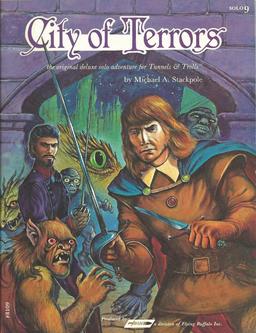 To make an SR, you roll 2d6 and add your attribute and try to beat a target number. Saving Rolls have Levels (a “Level 1 Saving Roll on Luck” is your basic luck roll, for example), and the target number is calculated as 15 plus (the level x 5): a Level 1 SR (a “L1SR”) has a target of 20, a L2SR a target of 25, and so on. When you roll 2d6, doubles add together and you get to roll again, meaning it’s possible to succeed at seemingly impossible SRs if you’re lucky enough.
To make an SR, you roll 2d6 and add your attribute and try to beat a target number. Saving Rolls have Levels (a “Level 1 Saving Roll on Luck” is your basic luck roll, for example), and the target number is calculated as 15 plus (the level x 5): a Level 1 SR (a “L1SR”) has a target of 20, a L2SR a target of 25, and so on. When you roll 2d6, doubles add together and you get to roll again, meaning it’s possible to succeed at seemingly impossible SRs if you’re lucky enough.
What you use an SR for depends on the attribute it derives from, and how clever you are at describing what you do. This latter point is vital to understanding T&T: there isn’t some rigid set of rules for exactly what SR covers what, but rather it’s a process of interpretation and negotiation. Sure, you’ll probably make a Strength SR to decide who wins an arm-wrestling contest, but if you describe yourself as batting your eyelashes seductively at your opponent, then maybe you can make a Charisma SR instead. Get creative — the game will sing.
DT&T incorporates a rule introduced in the 7th edition game: talents. Talents are areas of specialization, things your character is especially good at, and they provide modifiers to your Saving Rolls. The DT&T rules offer example talents, and those examples are presented as fairly concrete: things like Lockpicking, History, Animal Husbandry, etc.
In other games these would equate to skills. But they aren’t skills; there’s nothing to stop you defining talents as special abilities, or even personality traits. You could have a dwarf with Smells Metal as a talent, or a goblin with Hates Dwarves. You can use your talent modifier to add to your Saving Roll (any Saving Roll) when it’s appropriate (ie when you can effectively describe it); the default talent modifier is +3, but can increase to +7, +9, and more. You begin play with at least one talent, and you can get more as your character advances.
So that means that talents occupy the space which in other games is often taken up by skills; but also advantages, special abilities, relationships, personality characteristics, and even things like aspects if you play systems like Fate. They’re intentionally versatile, and can easily be tailored to suit your style of play, being more concrete and simulationist or abstract and narrativist as you like.
Core Mechanic 2: Combat
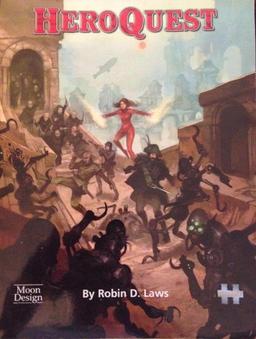 The second core mechanic of T&T is found in its combat system. This is radically different from traditional RPGs, and is likely the grand-daddy of extended resolution systems in games like HeroQuest and Fate, and it stands up very favorably in comparison with them.
The second core mechanic of T&T is found in its combat system. This is radically different from traditional RPGs, and is likely the grand-daddy of extended resolution systems in games like HeroQuest and Fate, and it stands up very favorably in comparison with them.
Here’s how it works. In a combat, each side rolls its “damage.” By default, DT&T portrays this as physical combat, but again there’s no reason it has to be — it could just as easily be social conflict, mental combat, etc. But let’s focus on physical combat, as that’s what’s assumed. In a combat, each side rolls the damage of the weapon or attack made by each combatant, including modifiers, and totals them together into one big “hit point total” (or HPT). Characters use weapons to determine the dice they roll; monsters generally use their Monster Rating. You then compare the two HPTs. The higher HPT “wins” the combat round, and the losing side must subtract the difference as damage, which is subtracted from your Constitution (again, in physical combat), or the Monster Rating if a monster. If there is more than one combatant on the losing side, the damage is shared out.
What constitutes a “side” in a conflict depends on the description of what’s going on — in story game parlance, it depends on “the fiction”. The same goes for damage. If you have two PCs, one at the back with a bow and one at the front with an axe, facing off against a stone troll, then probably any damage the stone troll does will affect the axe-wielding PC and not the archer at all — unless the description of how the troll attacks and how the defenders defend explains how. It’s very flexible, and encourages player immersion in the description of what’s happening.
Now, in itself this mechanic is good, but can boil down to an averages game pretty quickly; if you’re facing a foe which outclasses you, then you’ll tend to lose, far more reliably than in games such as D&D, where attacks are “two stage” (roll for attack, roll for damage). But, there is something very clever in the T&T rules, something which it’s easy to overlook, and which it’s essential to understand: stunts.
Stunts
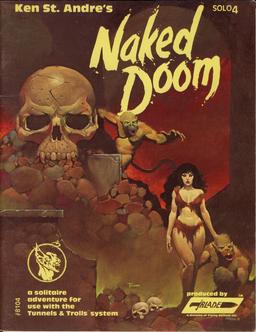 Now, if I have a beef with T&T in general, it’s that the rules have never made enough of explaining what these “stunts” are. Deluxe Tunnels & Trolls is no exception; it’s clear that everyone’s been playing so long, they’ve assimilated this play style so deeply that it’s become second nature. To be honest, though, I do think it needs explaining explicitly to people coming new to the rules, and at the moment it requires a bit of deduction to work it out for yourself. Even the terms “stunt” and “stunting” are absent from the rules.
Now, if I have a beef with T&T in general, it’s that the rules have never made enough of explaining what these “stunts” are. Deluxe Tunnels & Trolls is no exception; it’s clear that everyone’s been playing so long, they’ve assimilated this play style so deeply that it’s become second nature. To be honest, though, I do think it needs explaining explicitly to people coming new to the rules, and at the moment it requires a bit of deduction to work it out for yourself. Even the terms “stunt” and “stunting” are absent from the rules.
Stunting involves using Saving Rolls to “bend” the Conflict rules. In the rules, the key example revolves around ranged attacks. To fire a bow in T&T, you make a Dexterity Saving Roll, and if you succeed, your bow damage is done to your target even if your side in the conflict fails the combat round. If you fail the Dexterity Saving Roll, your bow shot still counts to your side’s total HPT effectiveness, but will only cause damage if your side also wins the round. It’s a simple mechanic, but it unleashes a whole lot of awesome during play.
Remember how I said that “the fiction” influences how you describe the results of the conflict mechanic? Well, how about this: you can use the Saving Roll mechanic to disarm a foe, kick sand in his face, disengage, taunt your opponent, and pretty much do anything else you can think of. You can use any attribute, and involve any talent; and the result of your Saving Roll can do any number of things, from tearing away your opponent’s armor, to making him roll unarmed damage if he’s been disarmed; to even halving his HPT damage roll (if he’s been tripped up) or even reducing it to zero (if he’s been blinded or dazed). The whole system is entirely dependent on your own creativity, and is quite wonderful in play; it’s one of the Big Unspoken Secrets of the T&T rules, and again has probably informed a lot of games that have come after.
The flipside of this comes with monsters. Monsters can have attributes and get involved with stunting, but often they’ll just have a Monster Rating, and no attributes to speak of (that “MR 25 Orc” again).
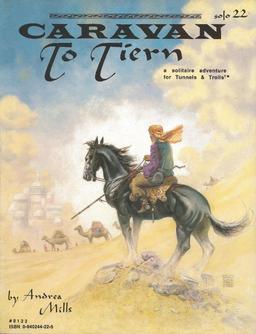 So how do you get all stunty with monsters if you’re a GM? Well, there’s a rule in DT&T called “spite damage,” which simply means that every natural “6” rolled on a die does one point of damage to an opponent, ignoring armor, and regardless of which side wins the round. It’s a neat way of preventing stalemates — but it also has a very cool side effect, one which began to come into play with 7th edition T&T and which is still very viable in DT&T too.
So how do you get all stunty with monsters if you’re a GM? Well, there’s a rule in DT&T called “spite damage,” which simply means that every natural “6” rolled on a die does one point of damage to an opponent, ignoring armor, and regardless of which side wins the round. It’s a neat way of preventing stalemates — but it also has a very cool side effect, one which began to come into play with 7th edition T&T and which is still very viable in DT&T too.
Basically, if a monster has a special ability (like “Fire Breath,” say, or “Terrifying Scream”), that ability can be triggered instead of one or more points of spite damage. In other words, if the GM rolls one or more sixes on a monster’s damage (ie attack) roll, then it breathes fire instead of just biting, or screams instead of clawing, etc — unleashing cool stunt effects like ignoring armor, reducing the opponent’s HPT, and so on. It’s a very elegant mechanic, and one which is also admirably suited for solo play, which has always been a big thing in T&T.
That’s why I said above that a “bestiary” could be a cool thing. It’s not essential to the DT&T rules — everyone knows what an orc does, or a basilisk, and the GM can come up with special ability stunts on the fly — but sometimes it’s good to provide lots of examples to get the GM’s creative juices flowing, or to enable solo play.
Should You Get It?
So, that’s my somewhat lengthy overview of the Deluxe Tunnels & Trolls game. The final verdict? Just buy it, right now. It’s awesome. The PDF is available at a very reasonable price, and Deluxe Tunnels & Trolls is packed full of fantasy RPG goodness. The physical versions are beautiful and well-made.
More importantly, it’s a great game; it has stood up to the test of time and can be played in both traditional and more “modern narrative” ways (and even a combination of the two). It’ll get you thinking. And there’s a truly huge number of solo adventures out there, plus “GM adventures,” which are completely compatible with the 8th edition rules. The game has a great pedigree, and is truly fun to play. I can recommend it heartily.
Deluxe Tunnels and Trolls is available in PDF from DriveThruRPG and in print from Flying Buffalo, Amazon, and friendly local games stores everywhere.
Sarah Newton’s last article for us was Kickstarting the Mindjammer Universe: A Far Future Transhuman Utopia?
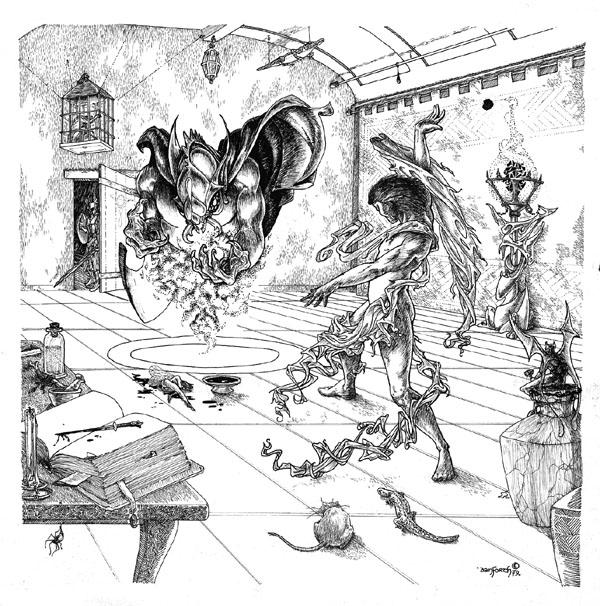
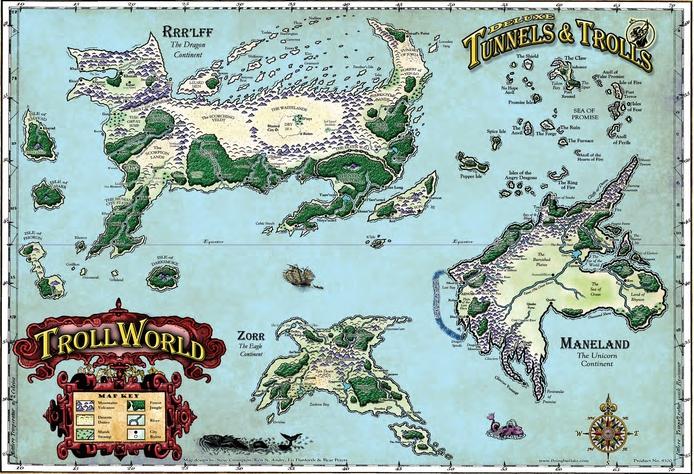
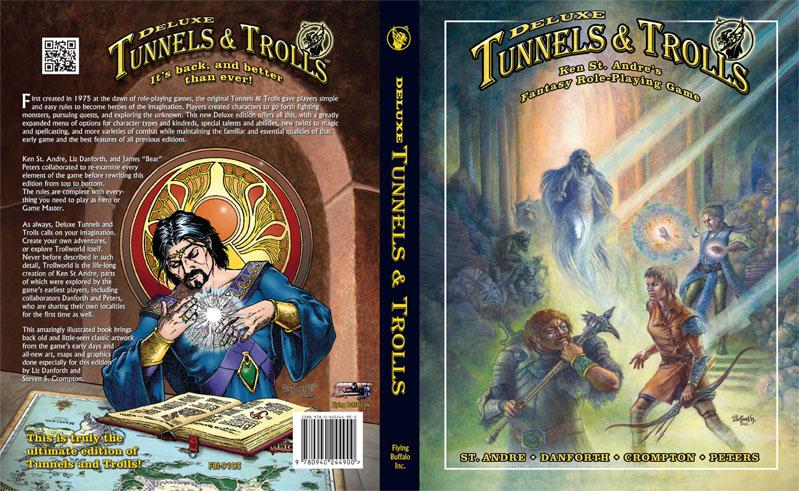
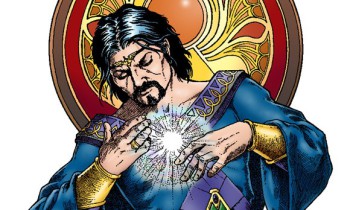
I bought the 7.5 rulebook several years ago but I could never get my DnD group to try it out. I have played 6 or 7 solo adventures (2 of those was actually with another player).
I love reading the rulebook to it and did so several times. I could get my boardgsme group to play TnT now but none of If hardly have the time.
Great article. I might have to pick up the 8th edition rules and get a game going. I’ve had a spoof King Arthur setting in the works for a while.
Back in the day, T&T could not break through the D&D chokehold on our gaming. But we did enjoy brief detours into Monsters! Monsters!, a Ken St. Andre game compatible with T&T, which put the players into the “monsters” role. Boy, villagers and their improvised polearms are actually quite tough, let me tell you!
And I should add that I have lately been reading over Legends of Anglerre and I have been more than impressed at the detail and care lavished on the system and the setting. Great work, Ms. Newton! Have you found T&T providing you any inspiration in your own designs like Anglerre or Mindjammer?
Glad to see T&T is still going strong. I have never had the opportunity to play the game but have long been aware of its presence and that it has an ardent following. I think the closest I have come to the game is reading the anthology “Mages Blood and Dry Bones” which flying buffalo put out years back. As I recall it was quite enjoyable.
> we did enjoy brief detours into Monsters! Monsters!, a Ken St. Andre game compatible with T&T…
Hear! Hear! Always glad to see a shout out for one of my favorite early RPGs, MONSTERS! MONSTERS! I wrote an article on it here years ago:
https://www.blackgate.com/2013/05/02/get-out-of-the-dungeon-with-monsters-monsters/
I note Glenn commented on that one, too. That guy is everywhere. 🙂
@Glenn: DT&T is good reading material as well as a grand game, Glenn – the setting section itself is like being told about a world you’d only glimpsed before, and so much of it makes sense. It’s lovely to see actual maps of places like Naked Doom, etc.
@Eugene: I’ve always been aware of “Monsters! Monsters!”, but I’ve only recently got hold of a copy now that it’s available in PDF on DriveThru. As well as being great fun it’s also a very serviceable proto-Bestiary for DT&T, with some excellent ideas for monster abilities and stunts. I *will* have to try and play it using the new rules!
Thanks for the great words about Anglerre! Reading DT&T has actually inspired me to pick up some of my very earliest RPG writing – Blackfear Dungeon for T&T 5th edition – and start unpacking it into a campaign setting and adventure pack, all the while keeping true to the vibe and tropes of the Tunnels & Trolls game experience. I’m really enjoying myself with it – you can see some of my maps and musings on my Meme Machine blog at http://sarahnewtonwriter.com/the-meme-machine/ See you there! 🙂
John, i only check to see if there are new posts like 5 or 6 (ok its more than that) times a day…I don’t have a problem. I can quit whenever i want.
Great point on the game being very narrative. Tunnels and Trolls is billed as this silly RPG that no one has played recently, but the community is still there and is very supportive. It doesn’t take much to pull the silly elements out of the game and use he system to run a more serious narrative game.
If you get into the game and want more. You can email Ken St. Andre and get invited to the community website Trollhalla. There’s and instand message system on the site that anyone can post on and there always seems to be someone on.
T&T is king of the solo adventure as well. a google search will bring you to a lot of fan made solo adventures and there are a lot more that only cost a couple bucks as a pdf.
I keep forgetting to put everything i want in one post.
I love Liz Danforth’s art. When i first bought the 7.5 edition i just kind of wrote the art off and didn’t think much about it. After I played the game and kept looking at the art more i grew to love it. She just captures overall theme of the game so well. I couldn’t imagine T&T without her artwork.
@Glenn: Agreed entirely about Liz Danforth’s art: she manages to really make black-and-white line art into a thing of beauty. Very clean, but also with a vibe of exoticism and true fantasy. Her visualisations of T&T really fit with the text perfectly; the game would be much diminished without it. I’ve often tried to pin down what it is: her pieces have so many little features of interest, each with their own stories, and her environments always lead to other places which promise even more adventure. They’re never static scenes, but stories and promises of more stories to come. Quite marvellous. 🙂
@Glenn: I’ve never really bought into the idea that T&T was at all “silly” – or, at least, it’s only silly in the way, say, Fafhrd and the Grey Mouser or Cugel the Clever are silly. It brings in wonder and whimsy, and allows for levity, in a way which emerges from the game and setting and doesn’t disrupt their underlying deadliness. From a world-building and story-telling point of view, that’s quite an achievement IMHO: T&T never becomes po-faced or self-indulgent, but at the same time the “comedy” always goes hand in hand with the “tragedy” in an organic way, without destroying the atmosphere (something which other games attempting levity often fall foul of).
[…] reviews like this one from designer/writer Sarah Newton left me astonished and awed. And this. Or this. Or this. Or this. […]